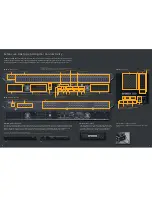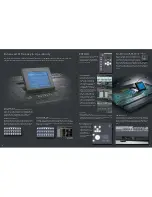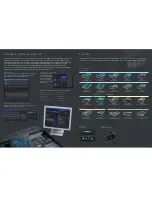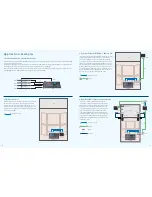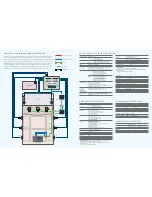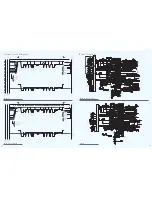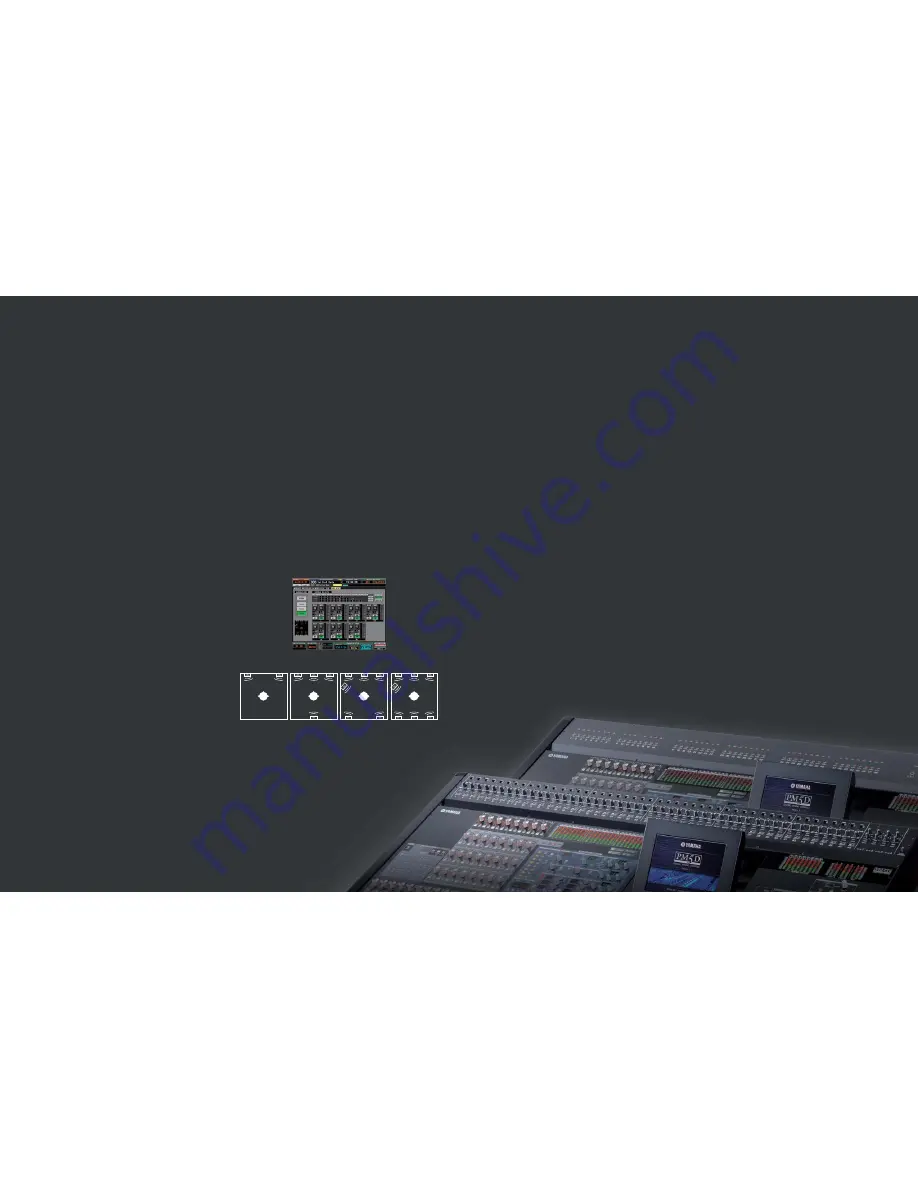
All the Effects and Processing You’ll Need Onboard
The PM5D V2 offers every processing facility you’ll ever need onboard. Every input
channel has 4 band EQ plus a high pass filter, a separate gate and compressor, and
delay of up to 1000 milliseconds. The stereo and mix outs have 8-band EQ,
compressor, and delay. The matrix outs have 4 band EQ, compressor and delay.
The cue and monitor outs also include delay. But the PM5D V2 doesn’t stop there!
It features twelve 31-band GEQs and eight independent SPX2000- class multi-effect
processors that can be patched into any of the console’s input, stereo, mix, or
matrix channels, offering a comprehensive range of reverb, delay, modulation, and
combination effects. The PM5D V2 also comes with Yamaha’s incomparable ADD-
ON EFFECTS built in! You have immediate access to acclaimed REV-X Reverb
programs as well as the Compressor276, Compressor260 and EQ601 programs
from the AE-011 Channel Strip package and the Open Deck programs from the AE-
021 Master Strip package.
Advanced, Intuitive User Interface
The PM5D V2 features interface technology developed and refined through an
impressive lineup of digital consoles, including the PM1D. Here are a few
highlights:
Selected Channel:
Press the SEL key on any input or master channel and that
channel strip is assigned to the console’s SELECTED CHANNEL controls for real-time
adjustment of a dazzling array of parameters. When you edit a parameter via a
SELECTED CHANNEL control block, the corresponding display is automatically called to
the console’s large LCD display for even further editing precision and versatility.
Mix Send Select:
With the PM5D V2 “vertical” and “horizontal” signal control
corresponding to channel and buss flow on a conventional analog console is intuitive
and efficient. For example; Press the MIX SELECT key corresponding to the desired mix
bus, and the send levels to the selected bus can be adjusted directly via the channel
strip encoders. If the MIX MASTER MIX SEND key is engaged, the send level from the
current SELECTED CHANNEL input to all 24 mix busses can be adjusted via the MIX
master encoders.
Encoder Mode:
The input channel encoders can be assigned to mix send level,
panning, input gain, or alternate layer input level, enabling the operator to adjust all
input channel levels without changing layers.
Flip:
When this key is engaged the functions of the input strip faders and encoders are
reversed ... this is great when you want to use the faders for fine control of a parameter
normally assigned to the encoders, which is ideal when using PM5D V2 for monitor
applications. The interface advantages are extensive, and extend to details that can
make a significant difference to work efficiency and comfort. Also there are connectors
for mouse and keyboard: great assistance when you have to type in numerous
characters while setting up patches and scenes.
Scene Recall
On the PM5D V2, all parameters are recallable in up to 500 scenes, so you can
instantly key to the perfect mix. This type of repeatability is particularly important
in high-turnover applications where you might need to accommodate a number of
totally different acts every day. It can also make life much easier in one-act touring
applications, leaving you more time to optimize the mix for individual venues.
There is also a flexible recall safe function that enables on-the-spot cancellation
and alteration of the pre-programmed settings.
HA Library
Another important feature on the PM5D V2 is an HA library that, on the PM5D-RH
V2, allows the gain and other parameters of the internal microphone preamplifier
to be recalled in one operation. The HA library is also an advantage on both the
PM5D V2 and PM5D-RH V2 when remotely-controllable preamplifiers such as the
Yamaha AD8HR are connected via the console’s expansion slots.
Surround Ready
The PM5D V2 is equipped with 3-1, 5.1 and 6.1 surround modes. You can easily
set up surround channels on the mix buses, and panning can be controlled via
the track pad or by using dedicated control devices connected via the MIDI or
GPI port.
Expansion Slots for Added Connectivity
Four rear-panel mini-YGDAI expansion slots allow you to use a range of MY series
expansion cards to enhance the PM5D V2 in a number of ways. You can, for
example, use the added I/O capability to connect to and remotely control high-
performance Yamaha AD8HR 8-channel A/D with microphone preamplifiers. You
could also significantly expand your audio processing capabilities by cascading to
a DME64N Digital Mixing Engine. You can have 64 matrix outs, and control
additional GEQ, Master fader, Cross Over, Delay and Matrix Mixer components
created on DME64N from PM5D. Or you could cascade-connect to another PM5D
V2 bi-directionally (up to 4 units uni-directionally) to create a huge system, or
other Yamaha digital mixers such as the DM2000 or DM1000 for submix
applications.
Virtual Soundcheck
Here’s a perfect example of a version-2 feature that has been implement in
response to feedback from the field. With a multi-track recording system such as
Steinberg’s Nuendo DAW, the PM5D V2 can not only be used to make top-quality
live recordings, but a live recording made during a rehearsal or performance can
be temporarily patched to the console’s inputs and used for setup and adjustment
when the musicians or performers aren’t available. The results of this “Virtual
Soundcheck” can then be directly saved to a scene without the need for complex
re-patching or fear of accidental changes to setting. And unlike similar features
found in other consoles, the PM5D V2 lets you assign individual channels to the
Virtual Soundcheck function as required, so you can keep sound effect or BGM
channels alive while doing a sound check.
Expanded Dynamics Capability
Next to level control and equalization, dynamics processing is one of the most
critical requirements for achieving optimum mix quality. That’s why the original
PM5D console included sophisticated compressors, expanders, and companders
on every channel. The PM5D V2 goes a step further by adding flexible de-essers
that can significantly enhance the quality of vocal and speech channels by precisely
isolating and compressing vocal sibilance.
Extra EQ
The PM5D’s eight SPX2000-class internal effect processors offer a vast amount of
DSP power. But since not every application requires full use of eight powerful
effect processors, some of that power may go unused. In version 2 that potential
can be put to good use in providing additional graphic and parametric EQ units.
The PM5D V2 offers a plentiful supply of independent equalizers for input and
output processing, but every engineer runs up against situations in which no
amount of EQ seems to be enough. That’s where the expanded EQ capability
provided by this new feature will really shine.
Solid Security
Although the original PM5D offered plenty of security-oriented features, version 2
provides even greater security that will keep the system operating properly in the
widest possible range of applications. A new Load Lock function, for example,
makes it impossible to inadvertently load data that might change critical settings
from external memory or the PM5D Editor. There’s also an Output Isolation
feature that allows full input channel control while preventing scene recall
operations from changing output compression, delay, EQ, fader, patching, and
other output parameters that needs to remain constant even through band or
program material changes. You can specify any or all of the output parameters you
want protected. And you can now assign “read-only” status to specific scenes to
prevent them from being overwritten by store, load, or edit operations.
Channel Move Function
This seemingly simple function can be a huge advantage when revising a channel
layout plan. Mono and stereo input channel setups can be “moved” to any other
channel in one simple operation so you don’t have to spend time re-entering all of
the related channel settings, including patch and HA settings.
R
L
C
R
L
C
R
L
LFE
Ls
Rs
C
R
L
LFE
Bs
S
Ls
Rs
STEREO
3-1
5.1
6.1
SURROUND SETUP
6
7







